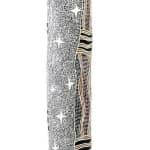Datjuluma Guyula Yolngu, b. 1973
86 5/8 x 4 3/4 in
Further images
Here the daughter of Naminapu Maymuru-White's sister has painted mythologies of Maŋgalili foundation that founded Djarrakpi and events that gave cause to this clans mortuary ceremony. It was in the wangarr, ancestral times, when the Guwak men, Munuminya and Yikawaŋa, sitting under the shade of the sacred Marawili tree, instructed the ancestral koel cuckoo Guwak to lead the Maŋgalili people to this new place they had established for them at Djarrakpi (Cape Shield- the easternmost promontory into Blue Mud bay at the far south of the Miwatj region). Having seen the people settled in their new homeland they announced to the Maŋgalili their farewell, that they, the Guwak men were to travel out to sea, to a place in the sky and that they would become stars which would shine out of the night sky. So a canoe and paddles were made and their journey began by paddling down the Milŋiya River which flows into the Blue Mud Bay to the West of Djarrakpi. In the bay, at a place of significance, strong winds developed and a wake from the ancestral turtle capsized the canoe - the men drowned. At this place is the site of Yiŋalpiya, the freshwater crocodile’s nesting place. This same place is the spirit source for Maŋgalili people. It is surmised by others that this event is either an ancestral tsunami or the inundation of the Gulf of Carpentaria at the end of the last Ice Age.
The capsizing of this canoe and the death and metamorphosis of these ancestral spirits into another dimension founds mortuary practice for this clan. The basic narrative of a canoe capsized and resultant death is mirrored in companion clans the Maḏarrpa and Dhalwaŋu who also each occupy separate peninsulas which jut into Blue Mud Bay to the West. Each of these clans inter their dead in a special ceremony based around a large sand sculpture called Yiŋapuŋapu. Whilst the songlines and stories and locations are different the form of the narrative is similar involving the inundation and death of canoe hunters. This ceremony commemorates this ancestral event and liberates the spirit from its earthly form and frees it to continue its infinite cyclical journey. In the case of the Maŋgalili the events of the incident are mapped in the voids of the Milky Way. The black shapes are more prominent to the naked eye in a clear Arnhem land night where the stars are a literal blanket in the absence of light pollution. The river of stars which is known by English speakers as the Milky Way is an analogue of the Milŋiyawuy River in an astral dimension.
So the Guwak men are identifiable but also the other elements of the songs. The Guwak sang in a tense which doesn’t exist in English. In 'everywhen' contemporaneous past/present/future. The songs they sang are the songs that are sung now which describe them singing themselves as they were capsized. They sing of the elements of the environment which sought to save them and of the Guwak declining that help. They were acceptant of their transformation into spirit form. These events are recorded in the dark voids within the Milky Way and the spirits of Maŋgalili follow this pathway to the infinite. A special log Milkamirri or Bandumul, containing mangrove worms offered itself as assistance. Ŋoykal the ancestral king fish is also manifest in this form. Even the rock cod they had caught for their journey offered assistance, as did Dhäla the sea creature. And mäṉa the shark. It was to no avail however as the men had destined themselves as offerings, to the night sky where they and subsequent Maŋgalili soles are seen today in the Milky Way.
SIGN UP TO OUR MAILING LIST FOR ALL THE NEWS
* denotes required fields
We will process the personal data you have supplied in accordance with our privacy policy (available on request). You can unsubscribe or change your preferences at any time by clicking the link in our emails.











